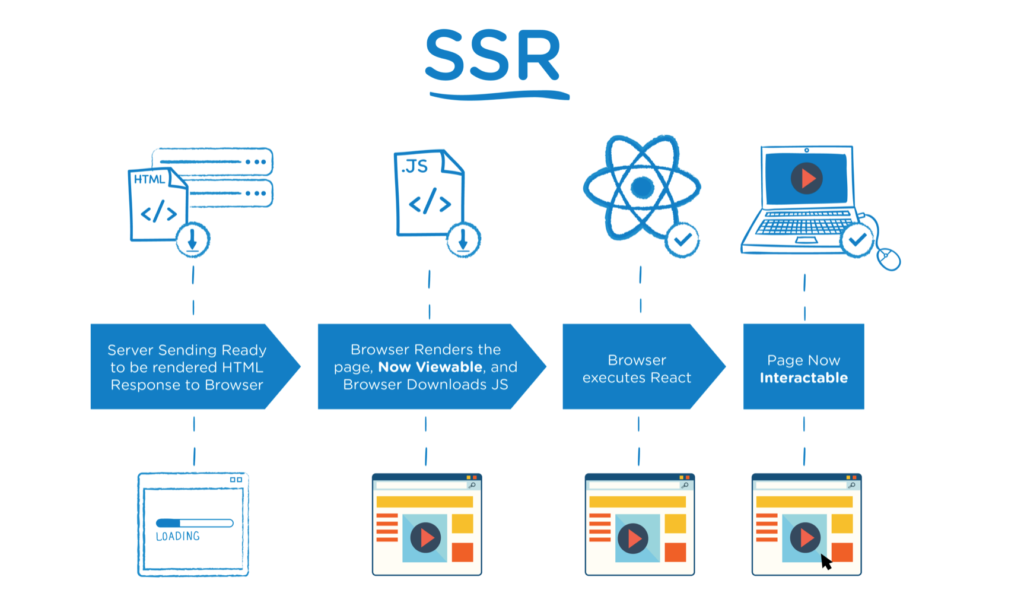Introduction
In web development, the way content is delivered to users plays a crucial role in website performance and user experience. Two common methods for rendering web pages are Server-Side Rendering (SSR) and Client-Side Rendering (CSR). Both have their own benefits and drawbacks, and understanding them can help developers make the right choice for their projects. In this blog, we’ll explore the differences between SSR and CSR, and which approach is better suited for different situations.
What is Server-Side Rendering (SSR)?
Server-Side Rendering (SSR) refers to the process where web pages are generated on the server. When a user requests a page, the server processes the request, fetches the data, and generates the HTML content that is sent to the client’s browser. Once the browser receives the HTML, it displays the content to the user.
Advantages of SSR:
- Better SEO: Since the HTML content is generated and sent to the browser, search engines can easily crawl and index the page, improving its ranking.
- Faster Initial Load: The user gets a fully rendered HTML page from the server, so they can see the content immediately after the page loads.
- Works on Older Devices: SSR does not rely heavily on JavaScript, making it more compatible with older devices and browsers.
Disadvantages of SSR:
- Server Load: SSR puts more load on the server, as it has to process each user request and generate the HTML page on the fly.
- Slower Interactions: While the initial load might be fast, subsequent interactions on the page could be slower, as they may require full page reloads.
What is Client-Side Rendering (CSR)?
Client-Side Rendering (CSR) is the process where the server sends a minimal HTML page and the JavaScript takes over the rendering process on the browser. In CSR, the content is generated dynamically by JavaScript, and data is fetched from the server asynchronously, which means parts of the web page can load at different times.
Advantages of CSR:
- Interactive Applications: CSR allows for dynamic updates of the page without requiring a full reload, making it ideal for highly interactive applications like Single Page Applications (SPAs).
- Less Server Load: Since most of the processing happens on the client side, the server workload is reduced.
- Seamless User Experience: With CSR, users can interact with the page without waiting for it to fully reload, leading to a smoother experience.
Disadvantages of CSR:
- SEO Challenges: Since search engine bots may not execute JavaScript, important content may not be indexed properly, affecting SEO.
- Slower Initial Load: CSR depends heavily on JavaScript, so users might experience a delay in seeing the content while scripts are being downloaded and executed.
- Not Suitable for Low-Power Devices: CSR can be slow on devices with limited processing power, as the browser is responsible for rendering the page.
SSR vs. CSR: A Comparison
| Feature | Server-Side Rendering (SSR) | Client-Side Rendering (CSR) |
|---|---|---|
| Initial Load Speed | Faster | Slower |
| Interactivity | Slower | Faster |
| SEO Friendliness | High | Challenging |
| Server Load | Higher | Lower |
| Compatibility | Works on older devices | Requires modern JavaScript support |
When to Use SSR?
- Websites where SEO is critical, such as blogs, e-commerce sites, and news portals.
- When you want fast initial load times for users on slower networks.
- When the server can handle the extra load.
When to Use CSR?
- Single Page Applications (SPAs) like Gmail, where interactivity and smooth user experience are essential.
- For applications where users frequently interact with dynamic content without needing to refresh the entire page.
- Projects where reducing server load is a priority.
Conclusion
Choosing between Server-Side Rendering and Client-Side Rendering depends on the nature of your project. SSR is excellent for SEO and initial load performance, while CSR shines in dynamic, interactive applications. For many modern web applications, a hybrid approach, combining SSR and CSR (such as Next.js or Nuxt.js), offers the best of both worlds. Consider your audience, project goals, and technical limitations before making your decision.
For expert web development services, including SSR and CSR implementation, visit TechsterTech.com. We specialize in improving website performance and SEO through the latest technologies.



